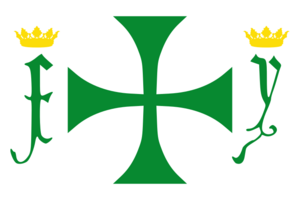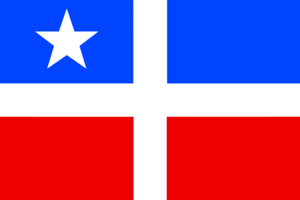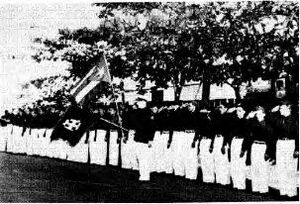List of Puerto Rican flags facts for kids

|
|
| Name |
|
|---|---|
| Use | Civil and state flag, civil and state ensign |
| Proportion | 2:3 |
| Adopted | August 3, 1995 adopted by the Puerto Rican government in 1995. It set the colors, and the medium blue triangle became the official shade. |

Variant flag of Puerto Rico
|
|
| Name |
|
| Use | Civil and state flag, civil and state ensign |
| Proportion | 2:3 |
| Adopted | July 24, 1952 adopted in 1952 when Puerto Rico became a commonwealth. The law described the colors, and a dark blue triangle became the common shade. |
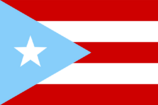
Variant flag of Puerto Rico
|
|
| Name |
|
| Use | Civil and state flag, civil and state ensign |
| Proportion | 2:3 |
| Adopted | December 22, 1895 created in 1895 by Puerto Ricans in New York who wanted independence. They chose red, white, and blue. Some believe the light blue color was inspired by the Grito de Lares flag. |
| Design | Five equal horizontal stripes, alternating from red to white, with a blue equilateral triangle based on the hoist side bearing a large, white, upright five-pointed star in the center |
| Designed by | Disputed between Puerto Ricans Francisco Gonzalo Marín in 1895 and Antonio Vélez Alvarado in 1892; Based on Cuban flag by Venezuelan Narciso López and Cuban Miguel Teurbe Tolón in 1849 |
Flags are special symbols that tell a story about a place and its people. This article explores the many flags of Puerto Rico. These flags show the history, hopes, and identity of the Puerto Rican people.
The most important flags include the current flag, which stands for the people of Puerto Rico today. There is also the historic Grito de Lares flag, used during a brave fight for freedom in 1868. You will also learn about flags for Puerto Rico's 78 towns, flags for different political groups, and flags used in sports events.
Contents
Early Flags of Puerto Rico
The first flags seen in Puerto Rico arrived with Christopher Columbus in 1493. He landed on the island and claimed it for Spain, naming it San Juan Bautista. Columbus used the royal flag of Spain. His captains carried white flags with a green cross and the letters 'F' and 'Y' for King Ferdinand and Queen Isabella.
Later, Spanish explorers led by Juan Ponce de León settled the island. They used a military flag called the Spanish Expedition Flag. Once Spain took control, the official flag of Spain flew over Puerto Rico, just like in other Spanish colonies.
The Spanish military built strong forts like La Fortaleza and Fort San Felipe del Morro. They used a special flag called the Cross of Burgundy. This flag showed where Spanish soldiers were stationed.
The First Puerto Rican Flag
In 1868, a movement for Puerto Rican independence grew stronger. A leader named Ramón Emeterio Betances asked Mariana Bracetti to create a special flag. This flag was for a planned uprising against Spanish rule. It was inspired by the flag of the Dominican Republic.
The flag has a white cross that divides it into four parts. The two bottom sections are red, and the two top sections are blue. In the top-left blue section, there is a white five-pointed star. Poet Luis Lloréns Torres explained its meaning: the white cross stands for hope for the homeland. The red squares represent the bravery of those who fought. The white star in the blue square symbolizes freedom.
This flag was used in a short but important rebellion known as the Grito de Lares (Cry of Lares). During this event, the flag was declared the national flag of a new "Republic of Puerto Rico." It was placed in the Catholic Church of Lares, becoming the first official Puerto Rican flag. One original flag was taken by a Spanish officer but later returned to the Puerto Rican people. Today, you can see it in the University of Puerto Rico's Museum.
After this, Spain changed its government. For a short time, from 1873 to 1875, Puerto Rico used a new colonial flag. This flag looked like Spain's flag but had the coat of arms of Puerto Rico in the middle. Spain's original flag returned until 1898. That year, Puerto Rico became a territory of the United States after the Spanish–American War.
Historical Flags of Puerto Rico
These are some important flags from Puerto Rico's past:
| Historical flags flown in Puerto Rico | ||||||||
|---|---|---|---|---|---|---|---|---|
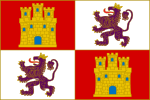 Flag of the Kingdom of Castile (1492) |
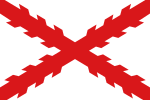 Burgundy Cross Flag (Spanish military flag) |
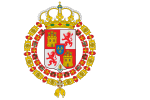 Flag of Spain (1701–1793) in fortresses and castles |
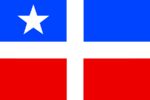 First Puerto Rican flag, the original revolutionary flag of the Grito de Lares revolt (1868) |
|||||
 Puerto Rico Provincial Flag (1873–1875) |
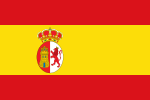 Flag of Spain (1793–1873, 1875–1898) |
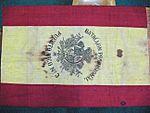 Spanish American War flag Flag of the Batallón Provisional No. 3 de Puerto Rico (3rd Provisional Battalion of Puerto Rico) |
 Flag of Spain (1873–1874) First Spanish Republic |
|||||
 Puerto Rican flag aboard the Space Shuttle Discovery March 15, 2009 |
||||||||
Flags of Puerto Rican Towns
Each of Puerto Rico's 78 towns, including the islands of Culebra and Vieques, has its own flag. These flags represent the town and its people. Their designs often come from the town's coat of arms.
For example, the town of Lares adopted the historic Grito de Lares flag as its official symbol in 1952. The flag of Utuado features a Taíno Sun. This honors the great Taíno leader Agüeybaná I, whose name means "The Great Sun." Other flags, like San Germán's, include a mural crown. This crown pays tribute to Spain and the Spanish settlers.
Political Flags
Throughout Puerto Rico's history, different political groups have created flags to show their beliefs. These flags are often seen during rallies or parades. They help show the strength and unity of a political party.
The Puerto Rican Nationalist Party flag has a white Calatrava Cross on a black background. The black color symbolized the sadness of Puerto Rico being a colony. This flag was often carried by the Cadets of the Republic, also known as the Black Shirts. They sometimes also used the light blue Puerto Rican flag from 1898 to 1952.
Puerto Rico has three main political parties today. The New Progressive Party of Puerto Rico wants Puerto Rico to become a U.S. state. Its flag has a blue palm tree on a white background. The Popular Democratic Party of Puerto Rico supports Puerto Rico's current commonwealth status. Its flag shows a red image of a Puerto Rican jíbaro (farmer) on a white background. The Puerto Rican Independence Party wants Puerto Rico to be an independent country. Its flag has a white cross, symbolizing purity, on a green background, which symbolizes hope.
The Puerto Ricans for Puerto Rico Party, founded in 2003, has a light brown coqui (a small frog) as its symbol. Its flag includes the words Por Puerto Rico (For Puerto Rico).
Another political flag belongs to the Boricua Popular Army, also known as Los Macheteros. This group believed in strong actions to achieve independence. Their flag shows a green machete and a red star on a black background.
Sports Flags
When Puerto Rican athletes compete internationally, like in the Olympics or Pan American Games, they proudly carry the current flag of Puerto Rico. Before the current flag was adopted for sports, athletes used a special white banner. This banner had a version of the seal and the words "Puerto Rico" on it.
The symbols on this old banner included a green background, representing the island's lush plants. It also featured the Lamb of God, symbolizing Jesus of Nazareth. The lamb sat on a book with seven seals, which refers to a story in the Book of Revelation.
See also
- Flag of Puerto Rico
- Coat of arms of Puerto Rico
- Seal of Puerto Rico
- Flag of Cuba, a similar flag with the red and blue reversed, and longer length
- Det Stavangerske Dampskibsselskap – A Norwegian shipping company with a virtually identical flag in its logo


